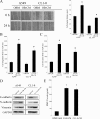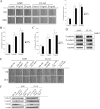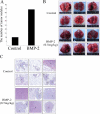Lung tumor-associated osteoblast-derived bone morphogenetic protein-2 increased epithelial-to-mesenchymal transition of cancer by Runx2/Snail signaling pathway
- PMID: 21885439
- PMCID: PMC3199481
- DOI: 10.1074/jbc.M111.256156
Lung tumor-associated osteoblast-derived bone morphogenetic protein-2 increased epithelial-to-mesenchymal transition of cancer by Runx2/Snail signaling pathway
Abstract
Bone is a frequent target of lung cancer metastasis and is associated with significant morbidity and a dismal prognosis. Interaction between cancer cells and the bone microenvironment causes a vicious cycle of tumor progression and bone destruction. This study analyzed the soluble factors secreted by lung tumor-associated osteoblast (TAOB), which are responsible for increasing cancer progression. The addition of bone morphogenetic protein-2 (BMP-2), present in large amounts in TAOB conditioned medium (TAOB-CM) and lung cancer patient sera, mimicked the inductive effect of TAOB-CM on lung cancer migration, invasion, and epithelial-to-mesenchymal transition. In contrast, inhibition of BMP by noggin decreases the inductive properties of TAOB-CM and lung cancer patient sera on cancer progression. Induction of lung cancer migration by BMP-2 is associated with increased ERK and p38 activation and the up-regulation of Runx2 and Snail. Blocking ERK and p38 by a specific inhibitor significantly decreases cancer cell migration by inhibiting Runx2 up-regulation and subsequently attenuating the expression of Snail. Enhancement of Runx2 facilitates Rux2 to recruit p300, which in turn enhances histone acetylation, increases Snail expression, and decreases E-cadherin. Furthermore, inhibiting Runx2 by siRNA also suppresses BMP-2-induced Snail up-regulation and cell migration. Our findings provide novel evidence that inhibition of BMP-2 or BMP-2-mediated MAPK/Runx2/Snail signaling is an attractive therapeutic target for osteolytic bone metastases in lung cancer patients.
Figures









Similar articles
-
Breast tumor-associated osteoblast-derived CXCL5 increases cancer progression by ERK/MSK1/Elk-1/snail signaling pathway.Oncogene. 2013 Sep 12;32(37):4436-47. doi: 10.1038/onc.2012.444. Epub 2012 Oct 8. Oncogene. 2013. PMID: 23045282
-
BMP2-activated Erk/MAP kinase stabilizes Runx2 by increasing p300 levels and histone acetyltransferase activity.J Biol Chem. 2010 Nov 19;285(47):36410-9. doi: 10.1074/jbc.M110.142307. Epub 2010 Sep 17. J Biol Chem. 2010. PMID: 20851880 Free PMC article.
-
Breast cancer cells obtain an osteomimetic feature via epithelial-mesenchymal transition that have undergone BMP2/RUNX2 signaling pathway induction.Oncotarget. 2016 Nov 29;7(48):79688-79705. doi: 10.18632/oncotarget.12939. Oncotarget. 2016. PMID: 27806311 Free PMC article.
-
Developmental pathways hijacked by osteosarcoma.Adv Exp Med Biol. 2014;804:93-118. doi: 10.1007/978-3-319-04843-7_5. Adv Exp Med Biol. 2014. PMID: 24924170 Review.
-
Metastatic bone disease: role of transcription factors and future targets.Bone. 2011 Jan;48(1):30-6. doi: 10.1016/j.bone.2010.05.035. Epub 2010 Jun 1. Bone. 2011. PMID: 20561908 Free PMC article. Review.
Cited by
-
MicroRNA 211-5p inhibits cancer cell proliferation and migration in pancreatic cancer by targeting BMP2.Aging (Albany NY). 2023 Dec 6;15(23):14411-14421. doi: 10.18632/aging.205320. Epub 2023 Dec 6. Aging (Albany NY). 2023. PMID: 38059889 Free PMC article.
-
Snail acetylation by histone acetyltransferase p300 in lung cancer.Thorac Cancer. 2017 May;8(3):131-137. doi: 10.1111/1759-7714.12408. Epub 2017 Mar 13. Thorac Cancer. 2017. PMID: 28296173 Free PMC article.
-
Loss of RUNX1 is associated with aggressive lung adenocarcinomas.J Cell Physiol. 2018 Apr;233(4):3487-3497. doi: 10.1002/jcp.26201. Epub 2017 Nov 1. J Cell Physiol. 2018. PMID: 28926105 Free PMC article.
-
miR-216 Is a Key Regulator and Potential Marker in Human Cancers.Adv Biomed Res. 2025 May 31;14:40. doi: 10.4103/abr.abr_184_23. eCollection 2025. Adv Biomed Res. 2025. PMID: 40519574 Free PMC article. Review.
-
Association Between BMP-2 and Carcinogenicity.Spine (Phila Pa 1976). 2015 Dec;40(23):1862-71. doi: 10.1097/BRS.0000000000001126. Spine (Phila Pa 1976). 2015. PMID: 26274524 Free PMC article.
References
-
- Roodman G. D. (2004) N. Engl. J. Med. 350, 1655–1664 - PubMed
-
- Rosen L. S., Gordon D., Tchekmedyian S., Yanagihara R., Hirsh V., Krzakowski M., Pawlicki M., de Souza P., Zheng M., Urbanowitz G., Reitsma D., Seaman J. J. (2003) J. Clin. Oncol. 21, 3150–3157 - PubMed
-
- Kvale P. A., Simoff M., Prakash U. B. (2003) Chest 123, (Suppl. 1) 284S–311S - PubMed
-
- Onishi T., Hayashi N., Theriault R. L., Hortobagyi G. N., Ueno N. T. (2010) Nat. Rev. Clin. Oncol. 7, 641–651 - PubMed
Publication types
MeSH terms
Substances
LinkOut - more resources
Full Text Sources
Medical
Research Materials
Miscellaneous

